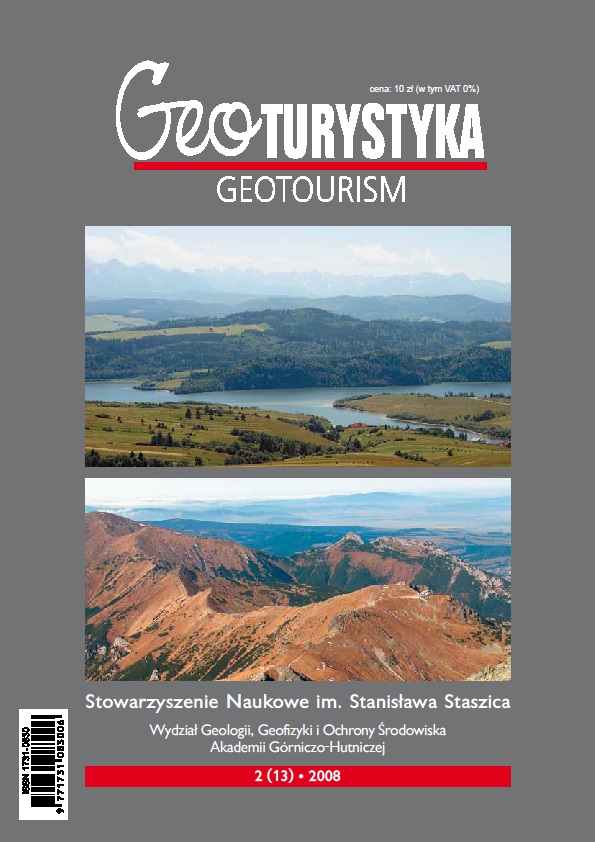Middle Jurassic black shales (Skrzypny Shale Formation) – palaeoenvironmental significance of one of the oldest deposits of the Pieniny Klippen Belt
DOI:
https://doi.org/10.7494/geotour.2008.13.19Słowa kluczowe:
Pieniny Klippen Belt, middle Jurassic, black shales, mikrostructure, clay minerals, Pieniński Pas Skałkowy, jura środkowa, czarne łupki, mikrostruktura, minerały ilasteAbstrakt
This paper deals with a fragment of geological history of Middle Jurassic black spherosideritic shales outcropping in upper part of the Homole Gorge (Skrzypny Shale Formation, Niedzica succession). These important deposits belong to the Flackenmergel facies, widespread in oceanic Tethyan deposits. This formation represents one of the oldest rocks of the Pieniny Klippen Belt. Dark colour of these rocks (total organic carbon content in them amounts to about 1 wt.%) and the occurrence of siderite concretions indicate reducing conditions of their origin but oxidizing environment of waters above them in sedimentary basin. Oxic conditions of organic matter sedimentation are confirmed by the elevated values of pristine to phytane ratio. Moreover the results based on n-alkanes indicate mixed terrestrial/marine origin of organic matter with prevalence of the last one These information are slightly obliterated because of advanced thermal maturity of organic matter caused by postsedimentation processes. Microstructural features of deposits of the Skrzypny Shale Formation and the composition of clay minerals occurring in them indicate late diagenetic conditions. In SEM images we observe one-directional orientation of clay minerals and rotation of mica flakes, often chloritized. Clay minerals are represented by high-illitic illite/smectite, micas, post-biotitic chlorite and subordinately kaolinite. As follows from authors studies, these macroscopically nearly “mute” clay rocks, little interesting in outcrops, particularly when they occur in such attractive geological objects as the Homole Gorge, can be the source of important information concerning the history of sedimentation basins.
//
Praca przedstawia fragment historii geologicznej środkowojurajskich czarnych łupków sferosyderytowych ukazujących się w niewielkim odsłonięciu w górnej części wąwozu Homole (formacja łupków ze Skrzypnego, sukcesja niedzicka). Te ważne utwory należą do facji Fleckenmergiel szeroko rozpowszechnionej w oceanie Tetydy. Formacja łupków ze Skrzypnego reprezentuje jedne z najstarszych skał pienińskiego pasa skałkowego. Ciemna barwa badanych skał (zawartość całkowitego węgla organicznego około 1% wag.) oraz występowanie w nich konkrecji syderytowych, wskazują na warunki redukcyjne panujące w osadzie, natomiast na obecność natlenionych wód nad osadem w środowisku ich sedymentacji. Sedymentację substancji organicznej w warunkach raczej utleniających potwierdzają badania związków organicznych, tj. wysokie wartości stosunku pristan/fitan. Wyniki tych badań wskazują ponadto na mieszane, lądowo/morskie pochodzenie substancji organicznej z przewagą ostatniej z wymienionych. Informacje te są nieco zatarte z powodu dużej dojrzałości termicznej substancji organicznej spowodowanej procesami postsedymentacyjnymi. Cechy mikrostrukturalne utworów formacji łupków ze Skrzyponego oraz skład występujących w nich minerałów ilastych wskazują na warunki odpowiadające późnej diagenezie. W obrazach elektronomikroskopowych (SEM) widoczna jest bowiem jednokierunkowa orientacja minerałów ilastych i rotacja blaszek mik, często schlorytyzowanych. W składzie minerałów ilastych występuje zaś wysokoillitowy illit/smektyt, miki, pobiotytowy chloryt i podrzędnie kaolinit. Z przeprowadzonych badań wynika, że makroskopowo niemal „nieme” skały ilaste, niepozorne wyglądające w odsłonięciu, szczególnie jeśli występują obok atrakcyjnych obiektów geologicznych jak to ma miejsce w wąwozie Homole, są źródłem ważnych informacji dotyczących historii basenów sedymentacyjnych. Warto więc zwrócić na nie uwagę.
Pobrania
Bibliografia
Birkenmajer, K., 1986. Stages of structural evolution of the Pieniny Klippen Belt, Carpathians. Studia Geologica Polonica, 88: 7-32.
Birkenmajer, K. & Narębski, W., 1958. Konkrecje węglanowe łupków aalenu pienińskiego pasa skałkowego Polski. Rocznik Polskiego Towarzystwa Geologicznego, XXVII, 51-74.
Demaison, G. J. & Moore, G.T. 1980. Anoxic Environments and oil source bed genesis. The American Association of Petroleum Geologists Bulletin, 64, 8: 1179-1209.
Krobicki, M. & Golonka, J., 2008. Geological history of the Pieniny Klippen Belt and Middle Jurassic black shales as one of the oldest deposits of this region – stratigraphical position and palaeoenvironmental significance. Geoturystyka (ten tom).
Morris, K. A., 1979. A classifcation of Jurassic marine shale sequence: an example from the Toarcin (Lower Jurassic) of Great Britain. Paleogeography, Paleoclimatology, paleoecology, v.26:117-120.
Potter, P. E., Maynard, J.B. & Depetris, P.J., 2005. Mud and Mudstones. Springer 297pp.
Moore, D.M. & Reynolds, R.C., Jr. 1997. X-ray diffraction and the identification and analysis of Clay Minerals.Oxford University Press. New York, 378.
Seilacher, A., 2001. Concretion morphologies reflecting diagenetic and epigenetic pathways. Sedimentary Geology, 143, 41-57.
Tyszka, J., 2001. Microfossil assambladges as bathymetic indicators of the Toarcian/Aalenian “Fleckenmergiel” – facies in the Carpathian Pieniny Klippen Belt. Geologica Carpathica, 52: 147-158.
Weaver, C.E., 1989. Clays, muds and shales. Development in Sedimentology 44. Elsevier, Amsterdam, 819pp.



